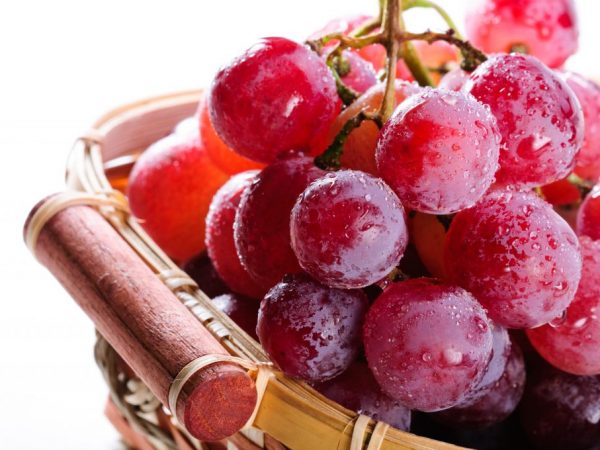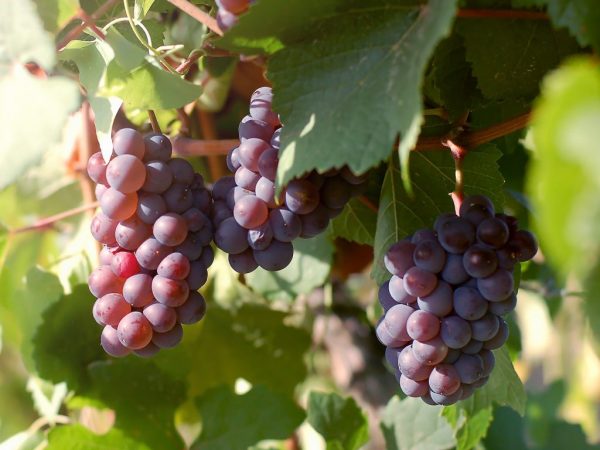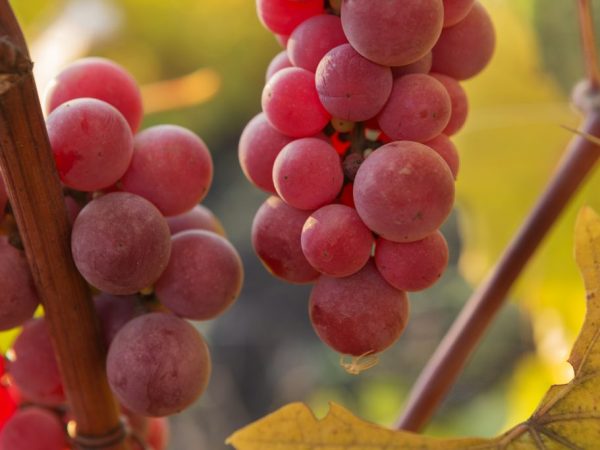Red grapes and its features
Red grapes are grown in all countries that practice wine. There are technical and table varieties, with early and late ripening. In terms of prevalence, red grapes are inferior to white and black varieties, but this does not in any way affect the taste and quality of the berries.

Red grapes and its features
Description and composition
The main feature of red grape varieties is the color of the fruit. They have a light, purple-lilac hue, there are ruby-red, almost scarlet berries. The peel is also darker, blue-violet. The juice of these varieties is always white or colorless, in contrast to the black varieties. Similar species are common in the wild, only in cultivars the color is slightly lighter.
The berry contains more than 150 biologically active substances. Anthocyanins give the peel and pulp a red hue. There are fewer of them in red varieties than in black ones, but this does not affect the usefulness of the berries. Anthocyanins increase immunity, the body's resistance to infections, and counteract cancer.
Flavonoids and catechins also affect the health of the immune system. They thin the blood, lower cholesterol levels. In addition, the fruits are rich in vitamins. The most important for the human body:
- Ascorbic acid, or vitamin C, - improves immunity, strengthens blood vessels
- Tocopherol, or vitamin E, - has antioxidant properties, counteracts the formation of free radicals.
- Retinol, or vitamin A, as well as its precursor beta-carotene, improves night vision, has a positive effect on skin, hair, nails, and local immunity.
- Group of B vitamins - they have an effect on hematopoiesis, have a positive effect on the nervous system, the state of the mucous membranes and the skin.
- Nicotinamide, or vitamin PP, - strengthens blood vessels, has an anti-allergic effect.
- Vitamin K - regulates blood clotting.
In addition to vitamins, fruits contain minerals. The high iron content helps to cope with mild anemia within 2-3 weeks. Potassium improves heart function. The pulp contains magnesium, copper, zinc, selenium, phosphorus, calcium and other elements.
The amount of BJU (proteins, fats, carbohydrates) in 100 g of the product:
- proteins - 0.70-0.72 g;
- fats - 0.15-0.16 g;
- carbohydrates - 17.1-17.3 g.
The rest is water. The calorie content of red grapes is low, only 69 kcal. Indicators vary, depending on the variety.
Beneficial features
Already from the analysis of the composition, it is clear that red grapes have beneficial properties. The combination of components has a positive effect on the human body. Berries are recommended to be consumed:
- Elderly and mature people to prevent cell aging.
- To strengthen the heart and blood vessels, reduce blood pressure.
- For the prevention of atherosclerosis.
- For chronic constipation.
- To improve memory, attention, prevention of Alzheimer's disease.
- As a prophylactic and auxiliary therapeutic agent in oncology.
- To strengthen the immune system and the body's resistance.
- For liver pathologies as a protector and choleretic agent.
- With reduced acidity of gastric juice.
- To reduce the side effects of chemotherapy.
- With nervous breakdowns, stress, depression, chronic fatigue.
- For joint diseases.
Fruits prevent vitamin deficiency, colds. They are good for respiratory diseases. Those who want to have a healthy heart should also eat these sweet berries.
The benefits of bones

It is recommended to eat berries with seeds
It turns out that not only berries contain biologically active substances. The benefits of red grape seeds for the body are no less, therefore, it is recommended to eat the fruits along with the seeds. They contain a large amount of antioxidants that neutralize the effect of free radicals on cell membranes. As a result, aging slows down, inflammation is relieved, and the risk of malignant transformation decreases.
Grape seed extract is often added to useful dietary supplements and tablets prescribed for the prevention of a number of diseases. Cosmetologists use it to make anti-aging and moisturizing creams. The bones contain substances with an antiseptic effect, therefore their extract relieves inflammation of the skin on the face, reduces acne.
Harmful properties
There are no products that only benefit. Red grapes are no exception. It is high in carbohydrates, organic acids, and calories that can negatively affect health. A number of conditions in which the berry is contraindicated and harmful:
- Diabetes. Fruits contain a lot of simple carbohydrates, especially glucose, so they are not recommended for patients with high blood sugar.
- Increased acidity of gastric juice. A number of components of berries and acids that are part of them irritate the stomach and increase the acidity of its juice.
- Intestinal disorders, diarrhea. Pectins and fiber increase intestinal motility and worsen patients' condition.
- Obesity. The calorie content of grapes is low, but it is higher than that of others (for example, citrus fruits or apples), therefore, it is not recommended to include berries in the diet for people with a large excess weight.
- Allergy. Red grapes cause allergic reactions in some people.
When using the fruits of culture, you need to know when to stop, otherwise they will be harmful. It is not advised to eat more than 600-700 g of berries per day. Overdose causes stomach irritation, heartburn, and sometimes allergies. Also, you can not combine berries with fatty foods, milk, carbonated drinks. In some people, grapes cause bloating, as a lot of gas is produced when glucose is digested. In such cases, it is worth limiting the use of berries, although there is no need to exclude it from the diet 100%.
Characteristics of varieties
People have been cultivating this species for several centuries, therefore, different varieties of red grapes have been bred. Some varieties are hybrids created by crossing different lines of the plant. They are conventionally divided into several groups.
By use:
- technical or wine;
- canteens.
Sometimes seedless raisins are isolated into a separate group. It is often used as a dining room. Raisins are also made from it, and this is already a technical processing.
Varieties are also divided according to the ripening period into:
- early maturing;
- mid-season;
- late ripening.
When choosing varieties, attention is paid to winter hardiness, immunity against fungal diseases and Pests, Taste qualities. They also pay attention to the adaptability to the conditions of a particular climatic zone. Almost all varieties retain the beneficial properties characteristic of this variety.
Description of varieties

Red grapes are good for winemaking
Most of the cultivars were developed in Europe. Some of them have been cultivated since the XIII-XIV centuries.Nowadays, mainly technical varieties are grown. They make wines of all categories, including elite.
A brief description of the popular red grape varieties:
- Cabernet Sauvignon. The variety appeared in France in the 17th century as a result of the crossing of Cabernet Franc and Sauvignon Blanc. The color of the berries is black, the juice is light. The variety is capricious, does not tolerate frost and drought. Refers to technical, almost all production goes to the production of wine with the same name. The taste combines pronounced currant notes with a black chokeberry and blueberry aftertaste. The aroma has tones of spices and flowers.
- Cabernet Franc. An early maturing technical variety with a long history. For several centuries it has been grown in Bordeaux. The color of the berries is dark, the shape is round. The bunches are cylindrical, the bushes are resistant to many diseases. The wine has a fruity flavor of blackberry and raspberry.
- Merlot. Another French variety that has the third largest vineyard area in the world. It comes from Garonne, although it is said that it first appeared in Bordeaux. The berries are black, round, and contain a lot of sugar in warm years. The variety is used for the production of young wines; only when the weather is favorable, the products are left for long storage. The taste is fruity, with hints of plum and currant.
- Pinot Noir. This grape variety is capricious and unpredictable, therefore it requires a lot of experience in growing. Rain, cold, drought, disease and pests can cause harm. Most of the vineyards are located in Alsace and the Loire Valley, but it is also cultivated in California, Australia. Pinot Noir produces elite rose and red wines, as well as champagne.
- Sira or Shiraz. A variety with low yield, but high disease resistance. Grows in France (where he comes from), Chile, Argentina, South Africa. Strong shoots, medium-sized clusters. The berries are black, slightly elongated. Syrah is used to make a strong, dense wine with the aroma of black pepper.
- Grenache. An ancient type of technical grape, it grows in France and Spain. The fruits are high in sugar. It is used to produce high quality rose and red wines.
- Cardinal. A table variety originated in the United States. Now it is widespread in European countries. The bunches of this variety are loose, large. The fruits are large, purple-red, covered with a smoky bloom. The shape is oval, the middle is fleshy, the skin is thick, there are 2-3 bones inside. The taste of the berries is nutmeg, sweet. This species is stored for a long time; it is sold in supermarkets until spring.
- Kordyanka. Moldavian table variety with large fruits. The bunches are conical, weighing 700 g or more. The fruits are oval, dark purple in color. The variety is distinguished by good winter hardiness, immunity to many fungal diseases. This grape is red in taste, sweet, with a slight sourness.
Many varieties are capricious, have an unstable yield, therefore they are grown in limited areas. Wine of these brands is expensive and highly valued all over the world.
Using
Red grapes have universal uses. Winemaking is in the first place. Most of the varieties are technical, they are grown on an industrial scale. The most expensive and elite red wines are produced from this variety of vines, which cost thousands of dollars per bottle. Massive and inexpensive brands are also produced on a large scale. Red wine varieties are cultivated in France. They are also grown in Spain, Italy, Greece, USA, South Africa, Chile, Argentina and Canada.
Table varieties, such as Cardinal, are sold in supermarkets. They have a sweet nutmeg taste with a slight sourness. Fresh berries are often used for desserts and baked goods. With their help, cakes, whipped cream are made out. It turns out delicious jelly from grape juice. There are varieties such as seedless raisins. Dried raisins are made from them. In many countries, leaves are also considered useful.They wrap rice, meat, make dishes similar to stuffed cabbage rolls.
Sweet berries, peels and seeds are used in medicine and cosmetology. The extract, in which red grapes and hawthorn are mixed, are used as a drug for the treatment of diseases of the heart and nervous system. Grape seed oil is part of skin rejuvenation creams. Masks are made from fresh berries. To do this, they are ground in a meat grinder and applied to the skin. The juice is part of complex home care products for the face.
Summarizing
The benefits of red grapes have long been proven. Its rich composition helps prevent and cure many diseases. Elite wines, delicious juices, jellies and preserves, even medicines are made from it. Low calorie content allows the use of berries for diet. On the basis of old varieties, new hybrids are being developed that can fully satisfy consumer needs.


